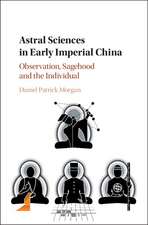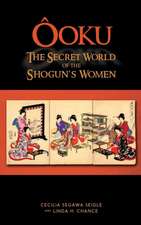Yoshiwara
Autor Cecilia Segawa Seigleen Limba Engleză Hardback – 28 feb 1993
Preț: 362.04 lei
Nou
Puncte Express: 543
Preț estimativ în valută:
69.28€ • 74.08$ • 57.76£
69.28€ • 74.08$ • 57.76£
Carte tipărită la comandă
Livrare economică 18 aprilie-02 mai
Preluare comenzi: 021 569.72.76
Specificații
ISBN-13: 9780824814885
ISBN-10: 0824814886
Pagini: 344
Dimensiuni: 154 x 234 x 27 mm
Greutate: 0.64 kg
Ediția:New.
Editura: University of Hawaii Press
ISBN-10: 0824814886
Pagini: 344
Dimensiuni: 154 x 234 x 27 mm
Greutate: 0.64 kg
Ediția:New.
Editura: University of Hawaii Press
Textul de pe ultima copertă
Yoshiwara is the first attempt in nearly a century to give a comprehensive and detailed account of Edo-period Japan's legendary pleasure quarter. The book begins with a brief history of prostitution in Japan and follows with a survey of the Yoshiwara from its origins in the early 1600s to shortly after the Meiji Restoration in 1868. Yoshiwara society possessed for most of its history considerable glamour and surface allure, yet, at the same time, it accommodated attitudes and activities that today could only be regarded as exploitative and inhumane. Cecilia Segawa Seigle looks impartially at all aspects of Yoshiwara life, offering much information - the result of painstaking research in primary sources - that will be a revelation to readers in the West. While discussing in depth the highly specialized and idiosyncratic world of licensed prostitution, Seigle also makes the reader aware of the broader impact of this insular entertainment quarter on the manners and mores of other segments of Japanese society, both then and now. Arranged chronologically, Yoshiwara is not so much a history as a companion to studies of Edo-period literature, theatre, and the visual arts. It provides an overview of the social, cultural, and economic influences on and of this microcosm of early-modern urban Japan. An especially engaging feature of this readable text is the liberal use of anecdotes from contemporary sources. Specialists will find particularly interesting the carefully researched and clearly written exposition of the quarter's complex hierarchy and elaborate code of behavior. While always maintaining the distinction between fact and fabrication, this fascinating study seeks to delineate thetruths that lie behind the legends.

















